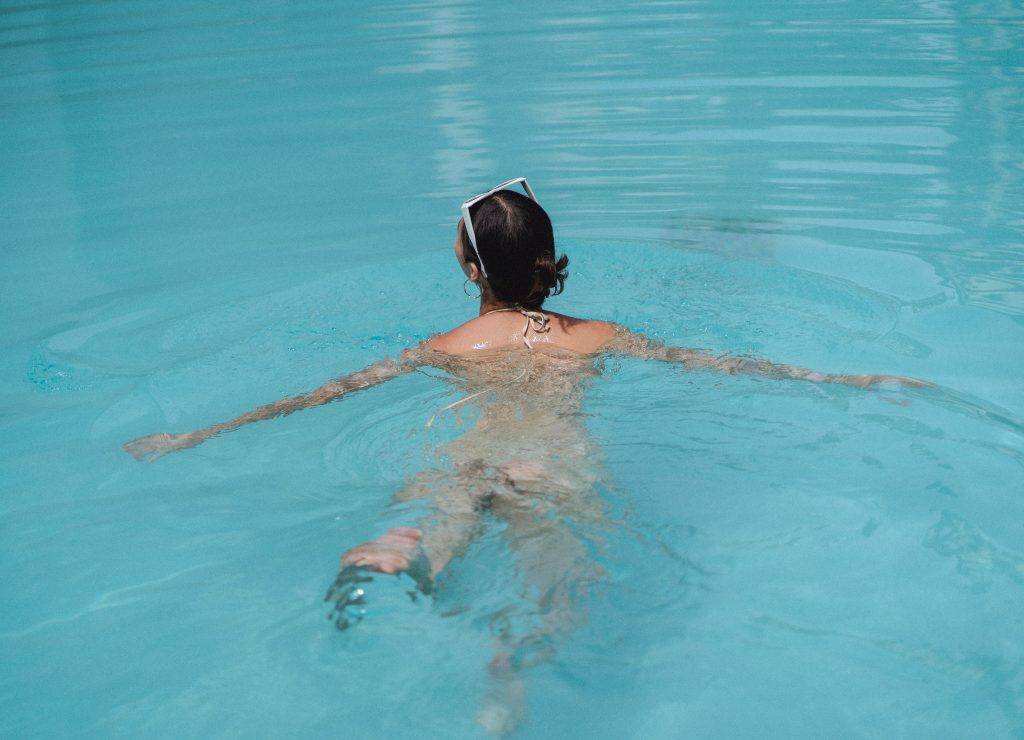Discover how water resistance can provide relief for back pain.
How Does Water Resistance Help Alleviate Back Pain?

If you suffer from back pain, you know how debilitating it can be. Simple, everyday tasks become a struggle, and even the thought of exercise can be daunting. But what if there was a way to alleviate your back pain while having fun in the water? Enter water resistance – a unique and effective solution that can make a splash in your pain management routine.
Understanding the Concept of Water Resistance
Before we dive into the benefits of water resistance for back pain, let’s first understand what it actually means. Water resistance is the force exerted on an object moving through water. When it comes to exercise, this can be harnessed to create a low-impact yet highly effective workout.
Water resistance is not just a concept limited to swimming. It can also be experienced in various water-based exercises such as aqua aerobics, water jogging, and water yoga. These activities utilize the resistance provided by water to challenge and strengthen different muscle groups in the body.
The Science Behind Water Resistance
When you move your body through the water, the resistance provided by this medium engages your muscles in a way that is gentle on your joints. It’s like giving your back a mini-massage while you work out! The water’s buoyancy also helps to support your body weight, reducing the strain on your spine.
Water resistance is influenced by factors such as the speed of movement, the surface area of the body in contact with the water, and the density of the water itself. These factors determine the level of resistance experienced during water-based exercises.
Water Resistance and Its Impact on the Human Body
But how does water resistance specifically help alleviate back pain? The answer lies in the way it engages and strengthens your core muscles. The buoyancy of the water challenges your body’s stability, forcing your core muscles to work harder to maintain balance. This not only improves your posture but also helps to alleviate the stress and strain on your back muscles.
Water resistance exercises also promote flexibility and range of motion, which are crucial for maintaining a healthy spine. The resistance provided by the water allows for controlled movements, reducing the risk of sudden jerks or strains that can aggravate back pain.
In addition to its physical benefits, water resistance exercises can also have a positive impact on mental well-being. The soothing properties of water can help reduce stress and promote relaxation, creating a calming environment for your workout.
Furthermore, water resistance workouts are suitable for people of all fitness levels. Whether you are a beginner or a seasoned athlete, the water’s resistance can be adjusted to meet your individual needs and goals.
So, the next time you’re looking for a workout that is gentle on your back but still provides a challenging and effective experience, consider incorporating water resistance exercises into your routine. Your back will thank you!
The Connection Between Water Resistance and Back Pain
Now that we understand the basics of water resistance, let’s explore how it specifically targets back pain relief.
Back pain is a common ailment that affects millions of people worldwide. It can be caused by various factors, such as poor posture, muscle imbalances, or injury. Finding effective ways to alleviate back pain is essential for improving quality of life and overall well-being.
The Role of Water Resistance in Reducing Back Pain
Water resistance exercises, such as water aerobics and hydrotherapy, can help to strengthen the muscles in your back. When these muscles are strong and well-supported, they are better equipped to handle the demands placed on them, reducing the likelihood of pain and discomfort.
Water resistance exercises involve performing movements in water, which provides a natural form of resistance. This resistance challenges the muscles in your back, forcing them to work harder than they would on land. As a result, these exercises can effectively target and strengthen the specific muscles that support your spine.
Additionally, water resistance exercises are low-impact, meaning they put less stress on your joints compared to traditional land-based exercises. This is particularly beneficial for individuals with back pain, as it allows them to engage in physical activity without exacerbating their symptoms.
The Therapeutic Benefits of Water Resistance
Aside from strengthening the back muscles, water resistance also provides therapeutic benefits. The resistance and support provided by the water help to improve flexibility and range of motion, allowing your spine to move more freely. This can lead to increased comfort and a decrease in back pain over time.
Water has a unique property that allows it to provide both support and resistance simultaneously. When you perform exercises in water, the buoyancy of the water supports your body, reducing the impact on your joints. At the same time, the resistance of the water challenges your muscles, promoting strength and stability.
In addition to improving flexibility and range of motion, water resistance exercises can also help to improve circulation. The hydrostatic pressure exerted by the water can enhance blood flow, which can aid in the healing process and reduce inflammation in the back muscles.
Furthermore, water resistance exercises can have a positive impact on your mental well-being. Engaging in physical activity releases endorphins, which are natural mood-boosting chemicals. The soothing and calming nature of water can also help to reduce stress and promote relaxation, which can indirectly contribute to a reduction in back pain.
Different Water Resistance Exercises for Back Pain
Ready to dive into some specific water resistance exercises for back pain relief?
Back pain can be a debilitating condition that affects millions of people worldwide. It can limit mobility, hinder daily activities, and overall decrease the quality of life. However, there are various ways to manage and alleviate back pain, and one effective method is through water resistance exercises.
Water Aerobics for Back Pain Relief
Water aerobics is a popular exercise choice for those with back pain, as it provides a fun and low-impact workout. In the pool, you can perform various aerobic exercises, such as jogging, jumping jacks, and cross-country skiing, all while benefiting from the buoyancy and resistance of the water.
When you immerse yourself in water, the buoyancy helps to support your body weight, reducing the impact on your joints and spine. This makes water aerobics an ideal exercise for individuals with back pain, as it minimizes stress on the affected areas while still providing a challenging workout.
Additionally, the resistance of the water adds an extra level of intensity to your exercises. As you move against the water, your muscles have to work harder, leading to increased strength and endurance. This can help to improve the stability of your back muscles, reducing the risk of future injuries and providing long-term relief.
Hydrotherapy Techniques for Back Pain
Hydrotherapy, or water-based physical therapy, can also be highly effective in alleviating back pain. Techniques such as floating, stretching, and gentle water massage can help to relieve tension and improve overall spinal health.
Floating in water can provide immediate relief by taking the weight off your spine and allowing your muscles to relax. This can help to reduce inflammation and promote healing in the affected areas. Additionally, stretching exercises in water can help to increase flexibility and range of motion, reducing stiffness and improving posture.
One of the unique benefits of hydrotherapy is the ability to receive gentle water massage. This involves the use of jets or underwater massage devices to target specific areas of your back. The combination of warm water and massage can help to increase blood flow, relax muscles, and release endorphins, providing natural pain relief.
It is important to note that before starting any water resistance exercises for back pain relief, it is essential to consult with a trained professional. They can assess your condition, provide proper guidance, and create a personalized exercise plan that suits your needs and abilities.
So, if you’re looking for an effective and enjoyable way to manage your back pain, consider incorporating water resistance exercises into your routine. Whether it’s water aerobics or hydrotherapy techniques, the benefits of exercising in water can help you find relief and improve your overall spinal health.
Safety Measures and Precautions in Water Resistance Training
Water resistance exercises are a fantastic way to stay fit and active while minimizing the impact on your joints. However, it’s important to take certain precautions to ensure your safety and avoid injuries. By following these guidelines, you can make the most out of your water workout without any unnecessary risks.
Ensuring Safety During Water Resistance Exercises
Before diving into your water workout, it’s crucial to properly warm up your muscles. Starting with gentle stretches on land and gradually transitioning to the water allows your body to adjust and prepare for the movements ahead. This warm-up routine not only enhances your performance but also reduces the risk of strain or injury.
Once you’re in the water, remember to maintain good posture and alignment throughout your exercises. This helps distribute the workload evenly and prevents unnecessary stress on specific muscles or joints. Engaging your core muscles and keeping your spine neutral are key aspects of maintaining proper form.
Furthermore, it’s essential to stay hydrated during your water resistance training. Even though you may not feel as thirsty as you would during a land-based workout, your body still needs an adequate amount of water to function optimally. Keep a water bottle nearby and take regular sips to avoid dehydration.
Precautions to Avoid Injuries in Water Resistance Training
While water resistance exercises are generally safe, it’s important to listen to your body and not push yourself beyond your limits. If you experience any pain or discomfort during an exercise, it’s crucial to modify the movement or consult with a healthcare professional. They can provide guidance on how to adapt the exercise to suit your individual needs and prevent further injuries.
In addition to paying attention to your body, it’s also important to be mindful of the water temperature. Extreme temperatures, whether too hot or too cold, can potentially exacerbate back pain or other existing conditions. Make sure the water temperature is appropriate for your comfort and consult with a professional if you have any concerns.
Lastly, always be aware of your surroundings when performing water resistance exercises. Ensure that the pool or body of water you’re using is clean and properly maintained. Check for any hazards such as slippery surfaces or objects that could cause accidents. By being vigilant and taking these precautions, you can create a safe and enjoyable environment for your water workouts.
The Long-Term Effects of Water Resistance Training on Back Pain
Consistency is key when it comes to reaping the long-term benefits of water resistance training for back pain relief.

Sustaining Back Pain Relief with Regular Water Resistance Training
Aim to incorporate water resistance exercises into your routine at least two to three times a week. This regularity allows your muscles to strengthen and adapt over time, leading to significant back pain relief and improved overall spinal health.
The Impact of Water Resistance Training on Overall Back Health
It’s important to note that water resistance training shouldn’t replace other forms of exercise or medical treatment for back pain. However, when used in conjunction with a comprehensive pain management plan, it can significantly enhance your overall back health and promote a more active lifestyle.
So, the next time you find yourself looking for a break from your back pain, consider taking a dip in the pool. With water resistance exercises, you can make a splash in your pain management routine while enjoying the therapeutic benefits of the water. Your back will thank you!



